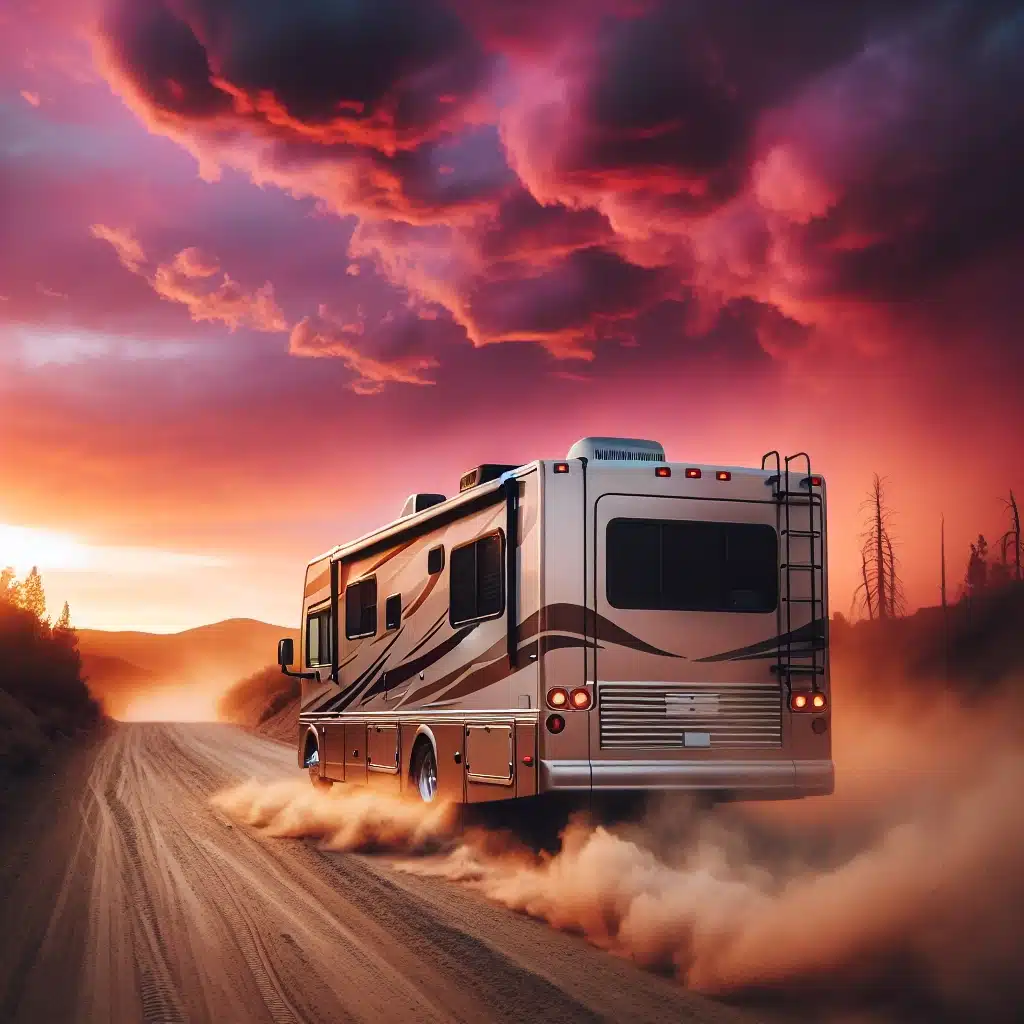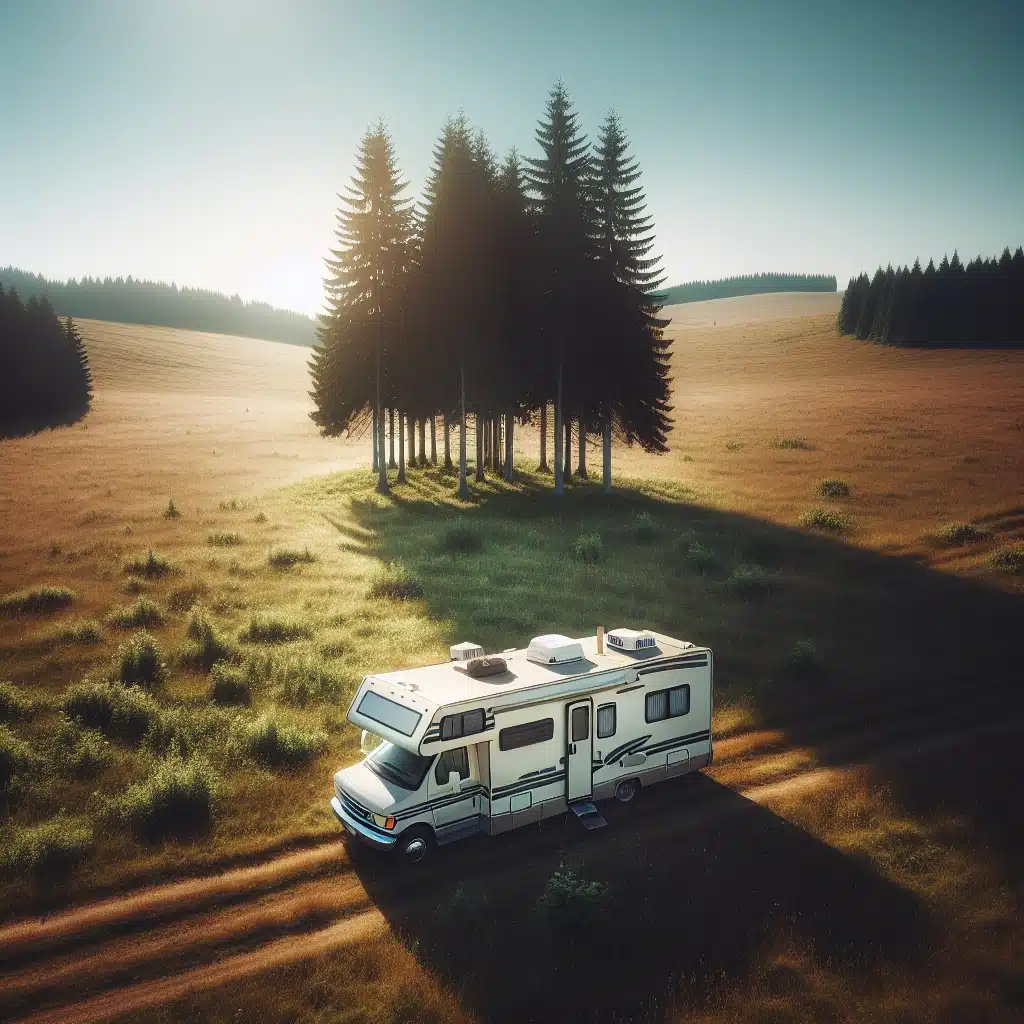Table of Contents

Maximizing Solar Efficiency for Off-Grid Adventures
When you’re out in the wild, miles away from the nearest plug, solar power isn’t just a convenience—it’s your lifeline. Harnessing the sun’s energy efficiently can mean the difference between a trip full of freedom and one hampered by power constraints. Let’s explore how to make the most of your RV’s solar system, ensuring you stay charged and ready for whatever the road brings.
Key Takeaways
- Understand the basics of solar power to make informed decisions about your RV system.
- Avoid common solar charging mistakes to maintain system longevity and efficiency.
- Learn how to assess your RV’s solar power needs based on your travel habits and energy consumption.
- Calculate your energy requirements to design a solar system that won’t leave you powerless.
- Stay ahead of maintenance and performance issues to enjoy uninterrupted off-grid adventures.
Understanding Solar Power Basics
Before you can optimize your system, you need to grasp the essentials of solar power. Solar panels convert sunlight into electricity, which is then stored in batteries for later use. The heart of this process is the photovoltaic cell, which does the heavy lifting. Think of these cells as tiny power plants, silently and cleanly turning rays into volts.
But it’s not just about the panels. Your system also includes a charge controller to regulate the power flow, batteries for storage, and an inverter to convert stored DC power into AC power for your appliances. It’s a symphony of components working in harmony, and understanding each part’s role is crucial for peak performance.
- Solar Panels: The sun-catchers of your RV, turning light into electricity.
- Charge Controller: The regulator, ensuring your batteries charge safely.
- Batteries: The storage units, holding onto that power until you need it.
- Inverter: The translator, turning DC power into usable AC power for your gadgets.
Common Pitfalls in Solar Charging
Even the best solar systems can stumble if not used correctly. One of the biggest missteps is underestimating your energy needs, leading to insufficient power when you need it most. Overloading your system can also shorten battery life and reduce efficiency. And let’s not forget maintenance—neglecting those panels can result in a significant drop in power output.
- Underestimating power needs leading to insufficient battery capacity.
- Overloading the system and causing premature battery wear.
- Ignoring regular maintenance, such as cleaning solar panels to maintain efficiency.
- Improper installation or angling of panels, reducing their sunlight exposure.
- Failing to monitor system performance to catch issues early on.
By steering clear of these common errors, you can ensure your solar system remains a reliable source of energy for all your journeys.
Assessing Your RV’s Solar Capabilities
Every RV is as unique as its owner, and so are its power needs. To tailor your solar setup to your specific requirements, start by evaluating what you have and what you’ll need. This means looking at your current energy consumption, the efficiency of your solar panels, and how well your batteries are holding up.
Imagine you’re planning a week-long journey to a remote mountain range. Your RV’s solar capabilities will determine how well you can live off-grid without sacrificing comforts like a cold fridge or a charged laptop.
Begin by noting down the wattage of your appliances and how often you use them. This will give you a rough estimate of your daily power consumption. Next, check the wattage of your solar panels and their average daily output. Finally, examine your battery capacity to see if it can handle your energy demands.
Calculating Energy Needs for Your Journey
Calculating your energy needs doesn’t have to be a headache. Start with the basics: how many hours a day you’ll use each appliance and the wattage each one consumes. Multiply these together to get your daily watt-hour total. Remember, it’s better to overestimate a little to avoid being caught short.
For example, if your fridge uses 60 watts and runs for 10 hours a day, that’s 600 watt-hours per day just for keeping your food cool. Add in lights, chargers, and other essentials, and you’ll see your daily total start to take shape.
Once you have your daily watt-hour total, compare it to the output of your solar panels. Can they generate enough power to meet your needs? If not, you may need to consider adding more panels or reducing your energy consumption. It’s all about finding that sweet spot between what you need and what you can produce.
Remember, solar power is about independence and sustainability. With the right setup, you can explore the great outdoors without leaving a trace, all while enjoying the comforts of home. So let’s get your RV ready for the ultimate off-grid adventure!
Breaking Down Solar System Components
Understanding the components of your solar system is like getting to know the members of a band—each plays a vital role in creating harmony. Your solar panels are the lead singers, capturing sunlight and turning it into electrical notes. The charge controller is the drummer, keeping the beat by regulating the flow of electricity to the batteries, which are the bassists, providing the deep, steady base of stored energy. Lastly, the inverter is the keyboardist, converting the tune into a melody that powers your RV’s appliances.
- Solar Panels: They capture solar energy and are rated by wattage output.
- Charge Controller: Protects batteries from overcharging and helps maximize their lifespan.
- Batteries: Store the solar power for use when the sun isn’t shining.
- Inverter: Converts DC electricity from batteries into AC electricity for everyday use.
Each component must be properly sized and matched to work efficiently. For instance, having a high-wattage solar panel setup but a small battery bank would be like having a powerful engine in a tiny car—it just doesn’t make sense.
Analyzing Battery Storage Options
Batteries are the unsung heroes of your solar setup, storing energy for when the sun bids farewell. The type and capacity of your batteries determine how long you can run your appliances off-grid. Lead-acid batteries have been the standard for years, but lithium-ion batteries are gaining ground with their longer lifespans and better energy density. Here’s what to consider:
- Capacity: Measured in amp-hours (Ah), it tells you how much power the battery can store.
- Depth of Discharge (DoD): How much of the battery’s capacity can be used without damaging it.
- Lifespan: The number of charge cycles a battery can handle before it starts losing capacity.
- Type: Lithium-ion batteries are lighter and last longer but come with a higher upfront cost.
Choosing the right battery is about balancing cost, capacity, lifespan, and weight. Think of it as packing for a trip—you want enough clothes to last the journey without overloading your suitcase.
Evaluating Charge Controller Efficiency
The charge controller is the gatekeeper of your solar system, ensuring that the power flowing to your batteries is just right—not too much, not too little. There are two main types of charge controllers: PWM (Pulse Width Modulation) and MPPT (Maximum Power Point Tracking). PWM is the more basic and cost-effective option, while MPPT is more efficient, especially in variable lighting conditions.
- PWM: Best for smaller systems or where high efficiency is not critical.
- MPPT: Ideal for larger systems and variable climates, as it can maximize energy harvest.
Think of your charge controller as a smart valve, adjusting the flow of electricity to prevent overcharging and undercharging, which can both shorten battery life. An efficient charge controller is one that provides just the right amount of power at the right time.

Enhancing Solar Performance for Boondocking
When you’re boondocking, every watt counts. Enhancing your solar system’s performance means you can stay off-grid longer and with more of the comforts of home. From upgrading your panels to tweaking your setup, there are several ways to boost your system’s output and reliability.
Upgrading to High-Efficiency Solar Panels
If you’re looking to get more power from the same amount of space, high-efficiency solar panels are the way to go. These panels use advanced technologies to convert more sunlight into electricity, making them perfect for RVs where roof space is at a premium.
- Look for panels with higher efficiency ratings, above 20% if possible.
- Consider the size and weight of the panels, especially if your RV has limited roof space.
- Monocrystalline panels are typically more efficient than polycrystalline.
- Remember that higher efficiency often comes with a higher price tag, but the investment can pay off in the long run.
Upgrading isn’t just about slapping on new panels; it’s about ensuring they’re the right fit for your energy needs and travel lifestyle.
Integrating MPPT Charge Controllers
MPPT charge controllers are like the brainy kids in class—they squeeze every bit of knowledge out of the material. In solar terms, they extract the maximum possible power from your panels by adjusting their electrical resistance to match the batteries. This is especially useful in less-than-ideal conditions, like partial shade or cloudy days.
- MPPT controllers can improve efficiency by up to 30% compared to PWM controllers.
- They’re particularly effective in colder climates where the voltage output of solar panels is higher.
- MPPT technology allows you to use higher voltage panels, which can reduce wiring costs and power loss.
While MPPT controllers come with a higher upfront cost, they can be a wise investment for serious boondockers looking to get the most out of their solar setup.
Expanding Battery Storage Capacity
Think of your battery bank as the fuel tank for your solar setup—the larger it is, the longer you can run. If you find yourself frequently running out of power, it might be time to expand your storage capacity. This doesn’t necessarily mean buying more batteries; it could be as simple as upgrading to batteries with a higher amp-hour rating.
- Consider the physical space available in your RV for additional batteries.
- Assess the weight implications of adding more batteries to ensure you don’t exceed your RV’s weight limit.
- Look for batteries with a higher energy density to get more storage without taking up more space.
- Remember that adding batteries means your solar panels and charge controller may also need an upgrade to handle the increased capacity.
Expanding your battery storage is a powerful way to enhance your off-grid capabilities, but it’s important to do so thoughtfully to maintain balance in your solar power system.
Implementing Energy Management Systems
Energy management systems are like the conductors of an orchestra, ensuring each section plays in perfect harmony. In an RV, these systems help you manage your power consumption by providing real-time data on energy usage and battery status. With this information, you can make informed decisions about when to conserve power and when you can indulge a little.
- Look for a system that provides detailed usage statistics and battery health.
- Choose a management system that allows you to set thresholds for energy consumption to avoid draining your batteries.
- Consider systems with remote monitoring capabilities so you can keep an eye on your power, even when you’re away from your RV.
Implementing an energy management system can make the difference between a stress-free adventure and one filled with power worries. It’s an investment in peace of mind.
Real-Time Solar System Monitoring
Monitoring your solar system in real-time is like having a dashboard for your RV’s energy health. It allows you to see exactly how much power you’re generating and using at any given moment. This level of insight is invaluable for maintaining an efficient and reliable solar setup, especially when boondocking.
Importance of Monitoring Solar Input and Output
Without monitoring, you’re essentially driving blind. Keeping tabs on your solar input and output helps you avoid energy shortfalls and ensures your batteries are charged and ready for use. It’s not just about the quantity of power; it’s also about the quality and consistency of the charge your batteries are receiving.
- Monitoring helps prevent overcharging and undercharging, both of which can damage batteries.
- Understanding your power production and consumption patterns can help you optimize your solar panel placement and usage habits.
- It allows you to detect any issues early, such as a drop in efficiency due to dirty panels or a failing battery.
Real-time monitoring is your window into the workings of your solar system, and it’s an essential tool for any RV owner serious about their solar investment.
Selecting the Right Monitoring Tools
There’s a wide range of monitoring tools available, from simple LED indicators to sophisticated systems with smartphone integration. The right tool for you depends on your needs and how deeply you want to dive into your energy data.
- Basic monitors can provide a quick glance at battery voltage and solar panel output.
- More advanced systems offer detailed analytics on energy consumption, efficiency, and even predictive weather adjustments.
- Some monitors come with built-in alarms or notifications for critical battery levels or abnormal energy usage.
Choosing the right monitoring tools is about finding the balance between information richness and user-friendliness. Opt for a system that gives you the data you need without overwhelming you.
Interpreting Data for System Optimization
Having data is one thing; knowing what to do with it is another. Interpreting the numbers from your monitoring tools can help you make adjustments to improve efficiency, extend battery life, and reduce wear on your system. This might mean shifting your energy usage to peak sunlight hours or identifying and replacing a poorly performing solar panel.
- Learn to read patterns in your energy usage to make proactive adjustments.
- Use historical data to plan for your energy needs based on past trips and conditions.
- Regularly review your system’s performance data to identify potential upgrades or maintenance needs.
By interpreting the data from your solar system, you can turn insights into action, ensuring your setup is always running at its best. With the right knowledge, you can squeeze every last drop of power out of those sunny days, keeping your adventures bright and your impact on the environment minimal.

On-The-Go Solar System Maintenance
Maintaining your solar system while on the move is as essential as checking your RV’s tire pressure. It’s not just about longevity; it’s about ensuring consistent, reliable power day after day. A well-maintained system can face the rigors of the road and the fickleness of the weather, keeping you powered up and ready to go.
Regular Check-Ups and Cleaning Practices
Like any well-oiled machine, your solar system needs regular check-ups. The most basic—and often overlooked—maintenance task is cleaning your solar panels. Dust, dirt, and bird droppings can significantly reduce your panels’ effectiveness. A simple cleaning with water and a soft brush can work wonders for your energy harvest.
- Inspect your solar panels regularly for any dirt buildup or debris.
- Clean your panels gently to avoid scratching the surface, which can reduce efficiency.
- Check all connections and cables for signs of wear or damage, especially after driving through harsh conditions.
- Ensure your batteries are topped up with distilled water if you’re using lead-acid types and check for any corrosion on the terminals.
Consistent maintenance not only improves performance but also helps you catch small issues before they become big problems.
Troubleshooting Common Solar System Issues
Even with the best care, solar systems can experience hiccups. Knowing how to troubleshoot common issues will keep you from being stranded without power. If your system isn’t performing as expected, start by checking the most obvious culprits: dirty panels, loose connections, or shaded panels.
- If your panels are clean and your connections are tight, use a multimeter to check the voltage output of your panels.
- Check your charge controller’s display for error codes or alerts that can indicate what’s going wrong.
- Examine your batteries for any signs of damage or wear, and test their voltage and specific gravity if applicable.
- Remember, if you’re not comfortable troubleshooting, seek help from a professional to avoid causing further damage.
Troubleshooting is about being methodical and patient. Often, the solution is simpler than you might think.
Securing Solar Panels for Harsh Weather Conditions
Your solar panels are built to withstand the elements, but extreme weather can still pose a threat. High winds can lift panels, and hail can cause damage. Securing your panels and ensuring they’re as protected as possible is key to weathering the storm—literally.
- Use sturdy mounting hardware designed for the weight and size of your panels.
- Regularly check the mounts and brackets for any signs of weakness or corrosion.
- Consider tilting your panels at an angle that allows snow and debris to slide off more easily.
- In the case of an impending storm, if possible, park your RV in a sheltered area to minimize exposure.
Properly secured panels will not only survive harsh conditions but continue to provide power when you need it most.
Frequently Asked Questions
How do I calculate the number of solar panels needed for my RV?
Calculating the number of solar panels you need for your RV involves a few steps but is crucial for designing an effective system. First, determine your daily power consumption in watt-hours by adding up the wattage of each appliance and how long you use them each day. Next, consider the average sun hours your panels will receive based on your typical travel locations.
Divide your daily power consumption by the number of sun hours to get the total watts of solar panels needed. Then, divide this number by the wattage of the solar panels you’re considering to get the number of panels required. Remember, it’s better to overestimate your needs slightly to account for inefficiencies and unexpected energy usage.
– Determine daily power consumption in watt-hours.
– Assess average sun hours per day for your travel area.
– Calculate total watts of solar panels needed by dividing daily consumption by sun hours.
– Divide total watts by the wattage of individual panels to get the number of panels.
With this calculation, you can ensure you have enough solar capacity to meet your energy needs while exploring the great outdoors.
What is an MPPT charge controller, and why should I consider it?
An MPPT, or Maximum Power Point Tracking charge controller, is like a smart manager for your solar power system. It constantly monitors and adjusts the voltage from your solar panels to match your batteries, squeezing out every bit of energy possible, even in less-than-ideal lighting conditions. Think of it as getting the most juice out of an orange with the least amount of squeeze.
– MPPT controllers can increase your system’s efficiency by up to 30% over PWM controllers.
– They work exceptionally well in varied weather conditions, making them ideal for boondocking.
– MPPT technology allows for the use of higher voltage panels, which can lead to less energy loss over long wire runs.
– While more expensive, the energy gains can lead to significant savings over time.
Consider an MPPT controller as an investment in your solar system’s future, providing more power and flexibility for your off-grid adventures.
How can I improve my RV’s battery storage for extended boondocking?
To keep the lights on and your fridge running during long stretches of boondocking, having ample battery storage is key. Improving your RV’s battery storage means either increasing the capacity of your existing batteries or upgrading to a more efficient battery technology.
– Upgrade to batteries with higher amp-hour (Ah) ratings to store more energy.
– Consider switching to lithium batteries for their longer lifespans and higher depth of discharge.
– Keep batteries in good health with regular maintenance and balanced charging.
– Optimize your energy usage to reduce the strain on your batteries.
– Ensure your solar array is large enough to recharge your batteries fully during the day.
By focusing on both capacity and efficiency, you can stretch your battery life and enjoy the freedom of boondocking without power worries.
What monitoring tools are recommended for keeping track of solar system performance?
Monitoring tools are the eyes and ears of your solar system, giving you real-time updates on performance and health. With the right tools, you can make informed decisions to keep your system running smoothly.
– Basic LED monitors provide a quick overview of system status and battery levels.
– More advanced monitors offer detailed insights into power production, consumption, and system efficiency.
– Smartphone apps connected to Bluetooth or Wi-Fi enabled controllers allow for remote monitoring and control.
– Integrated energy management systems can automate power-saving decisions based on your usage patterns.
Investing in a good monitoring setup helps you stay informed and proactive, ensuring your solar system is always at its best.
What maintenance does my RV solar system require while boondocking?
Maintenance is crucial for keeping your solar system in top condition, especially when you’re relying on it day in and day out. A little attention goes a long way in ensuring reliability and longevity.
– Regularly clean your solar panels to remove dirt, dust, and debris that can block sunlight.
– Inspect and tighten any loose connections to prevent power loss or potential safety hazards.
– Check your batteries for signs of corrosion, proper water levels (if applicable), and secure connections.
– Review your charge controller’s settings and updates to ensure optimal charging.
– Keep an eye on your monitoring tools for any sudden changes in performance that could indicate an issue.
Simple, consistent care will keep your solar system humming along, powering your off-grid lifestyle without a hitch.
In conclusion, taking the time to understand and optimize your RV’s solar system can transform your boondocking experience. From selecting the right charge controller to maintaining your batteries and monitoring system performance, every step you take towards efficiency is a step towards freedom. With the sun as your fuel, the horizon is your only limit. So go ahead, embrace the power of solar, and make your off-grid dreams a reality!
- Boondocking RVs: Flexible Solar Solutions – 3 March 2024
- Renewable Energy Tips for Full-Time Boondocking RVers – 2 March 2024
- Boondocking Solar Power Systems: Sizing Options & Solutions for Motorhomes – 1 March 2024
